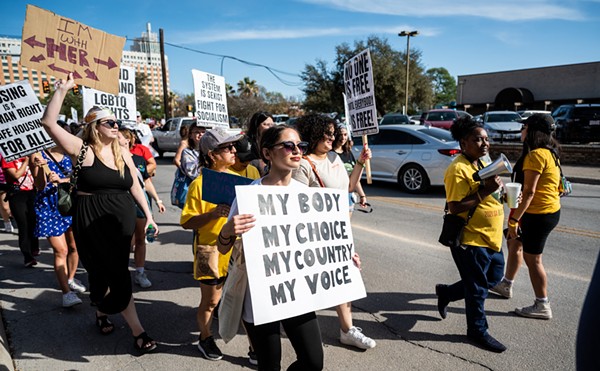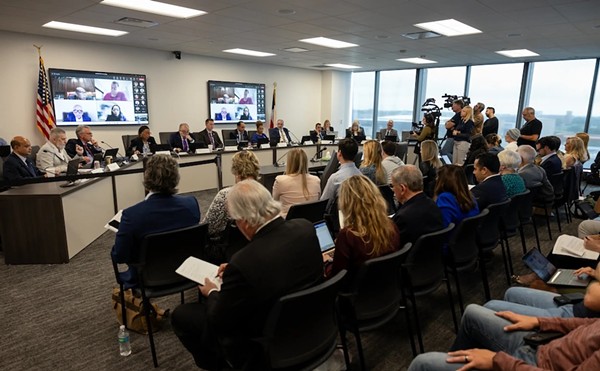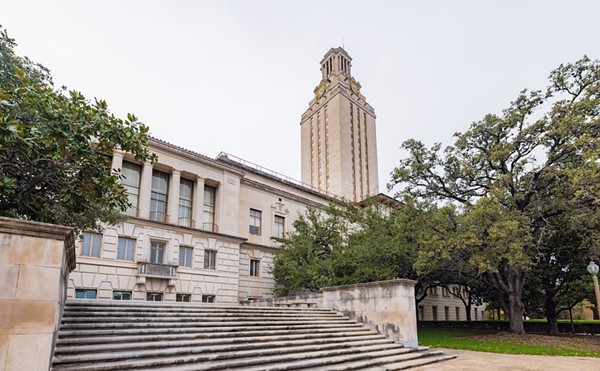Term limits were supposed to be the defining legacy of Mayor Phil Hardberger’s four-year tenure. At least that’s what the headlines last November kept insisting as news broke that the second-term mayor had successfully rallied the popular support needed to extend Council term limits from two, two-year terms to four, two-year terms.
But if the term-limit drive was to be his defining moment, Hardberger apparently didn’t get the message.
When he delivers his State of the City Address at the end of the month, San Antonio’s first “environmental” mayor is expected to roll out his most ambitious — and potentially his most influential — challenge to date. “Mission Verde,” the greening of Alamo City’s real estate, roadways, and industry, has been the subject of more than six months of study, numerous open- and closed-door meetings, and a smattering of consultants’ fees. If implemented, it is intended to place San Antonio — yes, this San Antonio, our sleepy military community built on sprawl and powered largely by coal — among the greenest of green U.S. cities.
Insert all of your favorite high-dollar eco-buzzwords here. Under Verde, we’ll have green tech and clean tech, low-emission transport, green-collar jobs, and when we clock out at day’s end, we’ll return to homes lovingly refurbished with hearty R values and solar-powered water heaters. That’s if all goes according to plan.
Driving Hardberger’s push for Verde have been the volatility of energy prices, a widely held belief (exempting a global recession or two) that the Era of Cheap Oil is over, renewed national interest in energy “security,” and the mother of all unintended consequences, climate change.
While San Antonio would be in no way unique in attempting to address these challenges at the municipal level, Verde would take its momentum from the bottom line first, according to Laurence Doxsey, the city’s environmental-policy director. While cities such as Chicago, Denver, and Seattle have embarked on ambitious programs aimed at drastically cutting their contribution of greenhouse gases like carbon dioxide (and, in turn, finding economic opportunity in “going green”), San Antonio is approaching the shift from the other side of the equation.
“The mayor’s approach is getting the economic question figured out first,” Doxsey said.
In a long sit-down interview, Doxsey spoke of the city “leading by example” and ensuring that “all boats rise together” under the new green regime. The plan Hardberger is expected to present hinges first on creating jobs; reduction of carbon-dioxide levels would be a happy byproduct.
“I know it’s a mantra, but it’s a smart one,” said Char Miller, head of Trinity University’s history department. “It’s a mantra that argues that the future is going to be derived around work that is aimed at sustainability, lessening the carbon footprint, greening everything from our houses to our workplaces. And if we can get the jump on that, then we’re in the 21st century. We’re not just struggling to deal with the 20th century’s problems, we’re actually leaping forward in a way that I think is quite imaginative and potentially quite remunerative for the community at large.”
Remunerative is nice.
Look at it this way, suggests Miller. “Take a house apart piece by piece and look at its construction and ask how can we do this better, in terms of retrofitting and new construction, and suddenly you’ve just rebuilt the economy — not just regionally, but nationally.”
Housing, Doxsey says, will be handled on two fronts. First, new-home construction standards will be tightened every few years until 2030, when all new buildings will be certified carbon-neutral. Second, a pilot program will upgrade the city’s existing residential properties, and hopefully, along the way, discover a workable funding model that would then unleash an army of tinkerers bent on improving the energy efficiency of homes across the city. Solar water heaters may be included in the new minimum standards.
To realize the full scope of a city-wide retrofit program will likely involve a public-private partnership funded by a locally managed capital fund worth tens of millions, Doxsey said. And while the individual home improvements will come with a price tag, the costs to homeowners will be offset by the energy savings.
The savings to be found in construction standards are obvious.
A recent City audit revealed that $25,000 spent replacing inefficient lighting at six San Antonio Police Department substations was recouped in less than two years in lower utility bills, Doxsey said.
Our transportation network would also receive major changes under Verde, with light rail high on the agenda. That, of course, hinges heavily on federal dollars. A list of draft recommendations by the Transportation Task Force established by Mayor Harderberger and County Judge Nelson Wolff includes several directives regarding light rail. VIA will be directed to plan a light-rail system while others (new House Speaker Joe Straus, anyone?) will be tasked with moving bills through the Texas Legislature to enable San Antonio residents to vote on funding rail via additional vehicle-registration fees or fuel taxes.
Tack onto all this expanded bicycle lanes, bike- and car-sharing programs, natural-gas filling stations, and aggressive green-tech pursuits by our economic-development gurus, and you have Verde in an avocado shell.
But what’s to ensure it gains the traction that will keep it from remaining simply one mayor’s glorious swan song?
Last year, the Chicago-based Center for Neighborhood Technology tagged the Alamo City a “low wage, high waste” economy of the most unsustainable sort. As if on cue, skyrocketing oil prices pushed gas prices into the $4 range. The presidential campaign had the airwaves buzzing with energy-security sound bites. Then the bottom began its free fall. President-elect Obama quickly knocked together an economic team and started talking stimulus. The air vibrates with expectation of a new New Deal and the hundreds of billions believed to be headed to U.S. cities.
However, top-tier recession response is no replacement for locally grounded sustainability ambitions, says Miller, author of On The Border: An Environmental History of San Antonio.
“To simply depend on top-down initiatives and funding is to miss an even bigger opportunity for the city to proclaim itself to be its own initiative, its own energizing force,” Miller said. “We’re all using this language of a New Deal. Well, one of the central problems of the New Deal `was` it was so hierarchical, so top-down, that states and cities sort of atrophied in terms of their … political reforms and the like. We don’t want to go there.”
So, it is likely the Mayor will use the next five months to build consensus on Verde, using his remaining influence — and banking his larger legacy — to get the three known mayoral candidates to sign on in a public way before voters hit the polls in May.
The time just may be right, as Miller suggests, for San Antonio to get “shrewdly idealistic.” Though we’ve understood the ramifications of our overly carbonated atmosphere for decades, actual federal penalties for greenhouse-gas production have only recently begun to materialize out of Washington, in contentious climate bills and a recent EPA verdict that carbon dioxide can be regulated under the Clean Air Act. Popular support for drop-kicking imported oil has solidified in the public mindscape. And increasing research and development dollars for new clean-energy technologies are expected to define the economy into the foreseeable future.
“The national and global economy is in the process of a major transformation leading from a carbon- and pollution-intensive economy to a carbon-constrained and low-pollution economy,” said James Nixon, board chair of California-based Sustainable Systems and one of the key consultants guiding Mission Verde. “This will mean that there are both tremendous business vulnerabilities and tremendous business opportunities. So what we’re trying to do ... is to look carefully at what those busininess opportunites are and to chart a course to try to take advantage of those in the context of also having a positive impact on San Antonio’s carbon footprint and on San Antonio’s level of energy use and level of water use and degree of resource sufficiency.”
More than 20 years ago, former Mayor Henry Cisneros sought to prod the city into the medical and high-tech worlds through Target ’90. Half the measure fell into place, but high-tech interests have instead gravitated to Austin. This time, the decision isn’t a matter of simply primping the economy with one flavor or another. Given the swelling tide of data regarding climate change, energy-market instability, and international investments careening into clean tech, the only real choice residents face is how fast to commit to cutting their use of fossil fuels, and how aggressively they seek to make San Antonio a center for all things sustainable.
Your next job may depend on it. •
Survey said, Say-town did
Consultants from the Chicago-based sustainability group the Center for Neighborhood Technology made a number of recommendations to San Antonio leaders after studying our energy economy.
Here’s what they said and what we’re doing:
Make a City-wide power plan. While utilities in the most frugal states spend up to 8 percent of their revenues on energy-efficiency programs, Texas power companies invest only about 2 percent in such programs, according to CNT. CPS Energy committed late last year to spend $685 million on efficiency programs aimed at reducing electricity demand by 569 megawatts within 12 years. That commitment equals about 3 percent of the utility’s revenue per year, if revenue remains static at 2007 levels. An earlier assessment by KEMA Consulting found the utility had the potential to reduce energy use by 1,220 megawatts.
Reduce energy waste in city buildings. Following the CNT recommendation, the City created a task force on sustainable building. Their recommendations are expected to include tightening building codes every three years to keep pace with revisions by the International Code Council and the American Society of Heating, Refrigeration, and Air-Conditioning. By 2030, all new construction in San Antonio must be carbon-neutral. A pilot program aimed at kick-starting a massive rehab program to super-insulate existing houses is also planned.
Streamline travel options. The goal of making transportation more efficient and less costly, while also reducing greenhouse-gas emissions, is expected to include light rail, mass-transit service expansion, and a variety of rideshare programs. Watch for heavy lobbying at state and federal levels to bag the money needed for rail and open new taxing options so Bexar County residents can help foot the bill.
Add it up. Communication is key: Better methods of comparing resource-saving strategies are on the way for City departments, CPS Energy, and the San Antonio Water System. Recent forest-canopy and greenhouse-gas-emission audits weren’t for naught. Expect ongoing exploration of private and public-private investments in emerging clean-tech industries and real-estate projects that offer “double bottom line” by going (and making) real green.


















